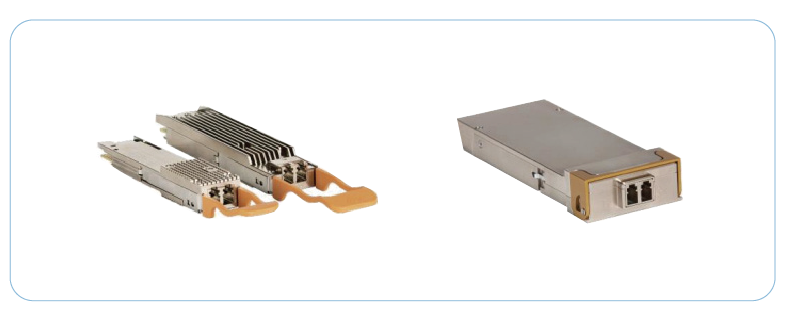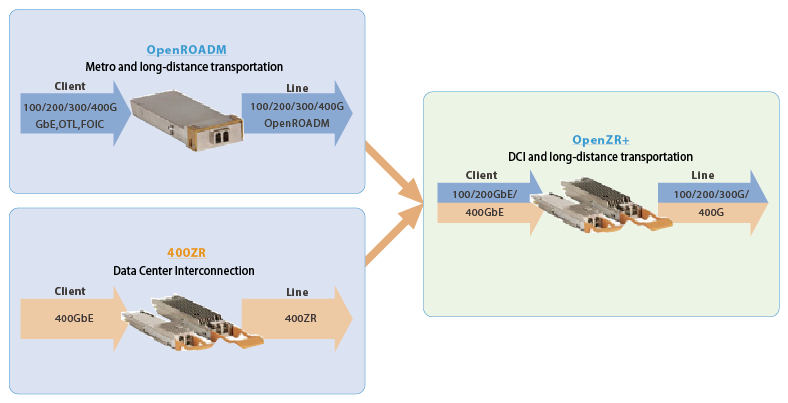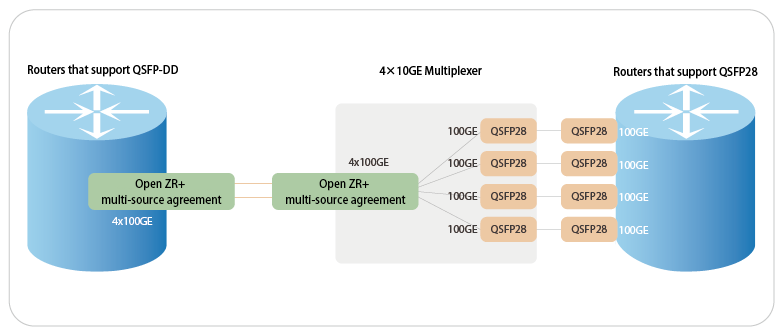The consumption of coherent optical links will usher in a blowout growth in the next few years. These new applications also put forward new requirements for the coherent optical transceiver system, which promotes the evolution of coherent transceiver units from the original integration with line cards and MSA transceivers to independent, standardized pluggable optical transceivers. This article discusses the development trend of pluggable coherent optical transceivers and compares and analyzes 400G coherent standards.
Development of Pluggable Coherent Optical Transceivers
Compared with the client optical transceivers used in the MAN or data center, the coherent optical transceiver unit used in the optical transmission network is usually built-in or integrated on the line side single board, with the disadvantages of low port density, large volume power consumption, non-standard design, etc. For a long time, network operators have hoped that the transmission optical transceiver has the same or similar form factor as that of the client optical transceivers. In recent years, advanced DSP chips with CMOS technique and integrated photonic technology have been progressing, making pluggable coherent package optical transceivers with smaller size and lower power consumption possible.
After years of development, standardized and pluggable optical transceivers have become a must choice for service transmission on the line side of optical communication. The development trend of coherent optical transceivers used in MAN and backbone networks has the following characteristics:
-High-speed: evolve from 100G/200G to 400G, and then to 800Gbps rate;
-Miniaturization: switch from the 100G MSA form factor to CFP/CFP2DCO/ACO, the current packaging standards are 400G OSFP DCO, QSFP-DD DCO, and so on (as shown in Figure 1);
-Low power consumption: Considering the overall system power consumption requirements, for example, the power consumption of coherent optical transceivers in the QSFP-DD form factor is not higher than 15W;
-Standardization of interconnection: Traditionally, equipment manufacturers use their own dedicated interface boards, and use proprietary high-order modulation methods and FEC algorithms. Interfaces of different manufacturers cannot communicate with each other. Therefore, the interconnection of coherent optical transceivers is the direction the industry has been working towards.
Figure 1 Pluggable coherent optical transceivers in three standardized packages (QSFP-DD, OSFP, CFP2-DCO)
200G CFP2-DCO and 400G QSFP-DD ZR are the most popular coherent optical transceivers in Fibermall.
-The features of 200G CFP2-DCO are as follows:
Available in a hot-pluggable CFP2 form factor
C-Band full-band tunable ultra-narrow linewidth laser
Transmission distance up to 80km/500km through a single-mode fiber
Using DP-QPSK modulation
Dual LC optical ports
Commercial grade operating temperature ranges from 0 to 70℃
Power supply voltage 3.3V
RoHS compliant (lead-free)
-400G QSFP-DD ZR:
Ideal for Edge DCI
Open Internetworking Forum (OIF) Compliant
Supports 400G data rates
Provides a reach up to 120km point-to-point
With the development of Internet services, the construction of cloud infrastructure, and the need for AI computing, telecom, and data center operators have put forward clear requirements for the interoperability of optical transceivers from different manufacturers.
In terms of FEC standards, there are different types such as GFEC, SCFEC, RS10, CFEC, oFEC, SD-FEC, etc., corresponding to different rates and standards, which can be generally divided into three generations: the first generation is block code, the gain requirement is 6dB, and the overhead is 6.7 %; The second generation is cascaded interleaving iteration, with a gain requirement of 8dB and overhead of 6.7%; the third generation is a soft-decision SD-FEC, with a gain requirement of 11dB and overhead of more than 25%, using Turbo Product Code (TPC) and low-density parity-check Code verification (LDPC) algorithm, and the new generation of FEC based on constellation probability shaping has not yet released a standard.
In terms of the DSP algorithm, taking 400ZR as an example, the frame format, non-differential coding, adjustment marks, symbol mapping rules, training sequences, pilot symbols, and other necessary information for intercommunication are standardized. In terms of MIS standards, there are already different standard types such as CFP MIS, C-CMIS, and CMIS. ZTE's coherent optical transceiver products have always been at the leading level in the industry. It has successively launched self-developed 100G/200G/400G/600G MSA transceivers and took the lead in the industry to launch 100G CFP, 200G/400G DCFP2 series pluggable optical transceivers, DCFP2/QSFP-DD and other highly integrated pluggable transceivers using self-developed optical and electrical chips are also being gradually developed.
Comparative Analysis of 400G Coherent Standards
The current commercial coherent technology has developed to single-wavelength 800G, but currently, 800G has no relevant standards in the industry, while 400G coherent technology has three standards: 400ZR, OpenROADM, and OpenZR+.
400ZR is a project started by the Optical Internetworking Forum (OIF) in 2016 to standardize an interoperable coherent optical transceiver interface with a power budget that can support form factors like QSFP-DD and OSFP for data center interconnection (DCI) 400G coherent optical transceivers. This form factor proposed by the OIF focuses on certain applications where transmission performance can be sacrificed because it needs to meet the 15W transceiver power target.
OIF-400ZR is aimed at edge DCI applications. The client side only defines a 400GbE rate, the transmission distance is 80~120km, and CFEC forward error correction is used. OIF has demonstrated that coherent interoperability standards are possible, and its proposed 400ZR solution is well supported in the industry. At the same time, system operators have proved that there is room for further improvement in the thermal performance of these high-density form factors, allowing optical transceivers with these form factors to support additional functions to provide higher performance.
On the basis of the success of OIF, telecom operators led by AT&T have defined the standard OpenROADM MSA that can support longer distance transmission. OpenROADM is designed for OTN networks that need to support other protocols and increase the corresponding overhead bit ratio. OpenROADM MSA is mainly for telecom operators' ROADM network applications. It defines 100G, 200G, 400GbE rates & OTN on the terminal interface, with a 500km transmission distance. It adopts an open FEC (oFEC) forward error correction algorithm.
400ZR and OpenROADM define the types and performance characteristics respectively of pluggable coherent optical transceivers for data center interconnection and telecom optical transmission networks, but each has certain limitations and shortcomings. For example, 400ZR only supports 400GbE client-side interfaces, while OpenROADM only applies to the network scenarios of telecom operators. Therefore, some mainstream manufacturers in the industry have combined the respective advantages of the OIF-400ZR and Open ROADM standards and launched another MSA standard, OpenZR+. The general evolution relationship of these three standards is shown in Figure 2.
Figure 2 Development and evolution of interoperability standards for coherent optical transceivers
OpenZR+MSA has a wider application range and aims at metro, backbone, DCI, and telecom operators, in order to achieve enhanced functions and improved performance in pluggable forms such as QSFP-DD and OSFP to support multi-vendor interoperability. OpenZR+ not only maintains the simple Ethernet pure host interface of 400ZR, but also adds support for multi-rate Ethernet and multiplexing functions of 100G, 200G, 300G or 400G line interface, and adopts the OpenROADM MSA and oFEC standardized by CableLabs, resulting in higher dispersion tolerance and higher coding gain. In September 2020, OpenZR+ released its first public version of the metrics book. The main performance indicators of coherent optical transceivers defined by the three standards of OIF-400ZR, Open ROADM, and OpenZR+ are shown in Table 1.
Table 1 Comparison of standard parameters of 400ZR, OpenROADM, OpenZR+ coherent optical transceiver interoperability
It is beneficial for network operators to use the same form factor on the line side optical transceivers as that of the client side, which reduces costs through simpler network architecture. Combined with the recent industry trend of Open Line System (OLS), these transmission optical transceivers can be directly inserted into routers without external transmission systems. This simplifies the control platform while reducing cost, power consumption, and footprint. For example, in the network application scenario shown in Figure 3, the user can choose to directly insert the coherent optical transceiver that meets the requirements of OpenZR+ into the port of the router supporting OLS, or insert it into the line-side port of the transmission device used to realize signal protocol conversion. , and then connect to the router through the client-side port of the device. Coherent DSP and coherent optical transceiver suppliers are actively conducting interoperability testing of coherent optical transceivers, such as Acacia, NEL, Inphi, NeoPhotonics, etc. At present, coherent optical transceivers with a short transmission distance can interoperate with multiple manufacturers.
Figure 3 Application that supports OpenZR+
Technology evolution analysis after the application of 400G coherence
From the perspective of standardization evolution, the next generation of 400G coherent pluggable products is likely to adopt a single-wave 800G rate. Recently, OIF is discussing developing a next-generation coherent technology standard--800ZR. At present, the initial consideration is to support 80~120km (amplified) DWDM links for DCI scenarios, and 2~10km links without amplification for campus scenarios. The client side interface supports 2×400GE or 1×800GE, and the line side supports a single-wavelength 800G coherent line interface.
The frame structure indicators are mapped from the client side to the line side and the signal indicators on the line side are defined to achieve interoperability. At the component level, OIF is also discussing the next-generation coherent modulator technical specification OIF-HB-CDM2.0 that supports higher modulation rates. Domestically, the CCSA Optical Device Working Group recently approved 6 projects of 800Gbps optical device industry standards, including 800Gbps IC-TROSA and 1×800Gbps phase modulation optical transceivers.
Therefore, the industry is also trying some new materials and device technologies, such as thin-film lithium niobate (TFLN). Lithium niobate has always been considered as a premium material for optical modulators. Traditional bulk material lithium niobate modulators cannot support baud rate applications above 64GBd due to their bulky size and bandwidth limited by device size. In recent years, due to the breakthrough of TFLN chip processing technology, lithium niobate modulators can also achieve small size and high bandwidth, so it is considered as a potential technique for realizing optical modulators of 100 GBd and above. In addition, to achieve high bandwidth at the device level, electric drive chips and packaging technology are also among the difficulties to be solved.




